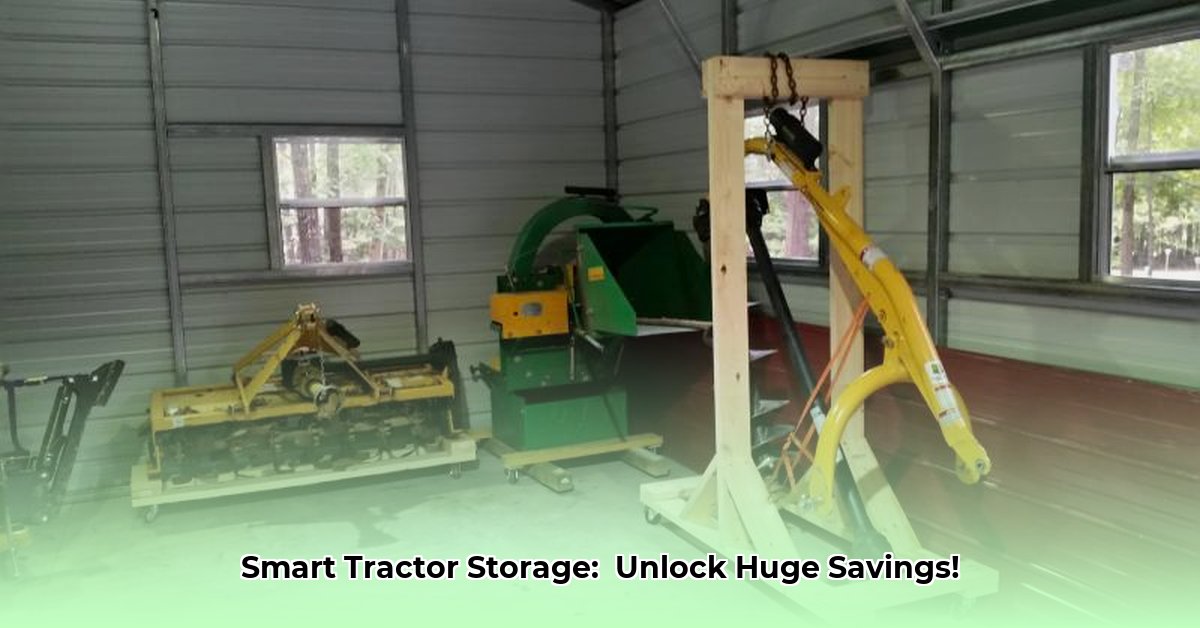
Smart tractor implement storage isn't just about finding a spot for your gear; it's about protecting your investment and making your farming life easier. This guide will walk you through the best ways to store your equipment efficiently and affordably, maximizing your return on investment and minimizing downtime. Let's get started!
Getting Started: Planning Your Tractor Implement Storage System
Before you invest in a new storage solution, take some time to plan. This will save you time, money, and headaches down the line.
- Inventory Your Equipment: Make a list of every implement you own, noting its size, weight, and unique storage needs. A small cultivator has different requirements than a large hay baler.
- Assess Your Climate: Consider your local weather patterns. Hot, humid summers require different solutions than harsh, snowy winters. Will you need protection from extreme temperatures, heavy rain, or strong winds?
- Set a Budget: Determine how much you're willing to spend. DIY options can be cost-effective, but pre-built structures often offer superior durability and weather protection. Remember to factor in the cost of materials, labor (if applicable), and any necessary tools.
- Analyze Your Space: Do you have a dedicated shed or barn? Will you need to build a new structure, or can you repurpose an existing one? Will you need outdoor storage for larger equipment, while smaller items can be stored inside? Careful consideration of available space is crucial in maximizing efficiency.
Actionable Step: Grab a notebook and pen (or open a spreadsheet) and complete your equipment inventory, climate assessment, budget calculation, and space analysis. This preparation is vital for selecting the right storage solution.
Choosing the Right Storage Solution for Your Farm
Your options for tractor implement storage range from simple, cost-effective solutions to more robust, weather-resistant structures.
Indoor Storage: The Ultimate Protection
Indoor storage offers the best protection against the elements, theft, and vandalism. However, it's often the most expensive option.
- Pros: Maximum protection from weather, improved equipment lifespan, easier maintenance and access.
- Cons: High initial investment (construction or repurposing costs), potential energy consumption for temperature control (heating or cooling), may require more extensive remodeling than other options.
Outdoor Storage Solutions: Balancing Protection and Cost
Outdoor storage offers various compromises between protection and cost. Choosing the right solution depends on your budget, climate, and equipment size.
- Basic Shelters: A simple roof and three walls made from inexpensive materials provide basic protection against rain and sun. Consider the structural integrity carefully to make sure items and people are safe.
- Improved Shelters: Well-built sheds, metal buildings, or even repurposed shipping containers offer considerably better protection from the elements and increased security.
- DIY Options: Get creative! Building a simple lean-to or adapting existing structures can be a cost-effective solution, but structural integrity is paramount here. Always evaluate the safety of the structure to prevent collapse.
Actionable Step: Research local building codes and contractors to assess your options for creating adequate storage for your equipment.
Maximizing Space and Organization: Efficiency is Key
Regardless of your chosen storage solution, efficient organization is essential for maximizing space and minimizing downtime.
- Clean Your Implements: Thoroughly clean each implement before storage. Remove mud, debris, and plant matter to prevent rust and corrosion. Using a pressure washer can speed up the process.
- Perform Routine Maintenance: Lubricate moving parts, tighten bolts, and address any damage. Preventative maintenance saves money and keeps implements in optimal condition.
- Strategic Organization: Arrange equipment logically, placing frequently used items within easy reach. Consider designating specific areas for different implement types. Clearly label everything for easy identification.
- Optimize Vertical Space: Maximize space using shelves, racks, or hanging systems for smaller implements.
Actionable Step: Clean and perform routine maintenance on each implement before storing it. Consider creating a detailed storage plan, mapping out the placement of each implement in your storage area.
Protecting Your Investment: Weatherproofing Strategies
Proper weatherproofing is crucial for preserving your equipment and avoiding costly repairs.
- Tarps: Heavy-duty, waterproof tarps offer basic protection from rain and sun. Secure them properly with ropes, straps, or weights to prevent damage in high winds.
- Custom Covers: Specialized covers tailored to individual implements offer superior protection. Although they are more expensive than tarps, they provide custom protection against rust and damage.
- Enclosed Storage: This offers the ultimate protection from the elements. Even a simple shed will be significantly more protective than leaving items exposed to weather.
Actionable Step: Evaluate your climate and equipment needs to choose the most appropriate weatherproofing for your situation. Investing in high-quality materials will pay off in the long run.
Sustainable Storage: Eco-Friendly Practices
Incorporate sustainable practices into your tractor implement storage plan. Here are a few ideas:
- Recycled Materials: When building or modifying storage structures, prioritize recycled materials such as reclaimed wood or recycled steel.
- Energy Efficiency: Use energy-efficient lighting (solar powered is ideal) and consider passive ventilation techniques to reduce your environmental footprint.
- Water Conservation: Implement rainwater harvesting if possible.
Actionable Step: Research sustainable building materials and practices available in your area.
Next Steps: Putting It All Together
- Assess: Evaluate your current storage situation and identify your most pressing challenges (space, weather protection, organization, etc.).
- Plan: Develop a comprehensive storage plan, including the type of storage, weatherproofing, and organization system.
- Implement: Construct or purchase your chosen storage solution and organize your implements according to your plan.
- Maintain: Regularly clean and maintain your equipment and storage area to ensure longevity and efficiency.
- Review: Periodically review your storage system and make adjustments as needed. Flexibility is key for adapting to changing needs.
By following these steps, you'll create a smart, efficient, and cost-effective tractor implement storage system that ensures your equipment lasts longer and your farm operates more smoothly. Remember, proper storage is an investment in your farm's future success.